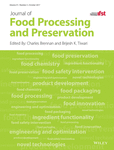Vacuum drying of Chilean murta (Ugni molinae Turcz) berries: Effect of temperature on kinetic parameters and assessment of energy consumption
Funding information: The authors gratefully acknowledge the Research Department of Universidad de La Serena (DIULS) Project PR15332 and Fondecyt Regular Project No. 1140075 for providing financial support for the publication of this research
Abstract
Vacuum drying characteristics of murta (Ugni molinae Turcz) berries were evaluated. Drying experiments at a pressure of 15 kPa and temperatures ranging from 50 to 90 °C in a vacuum oven were carried out. The effect of drying pressure and temperature on the drying rate was also evaluated. A suitable model for describing the vacuum drying process was chosen by fitting eight mathematical expressions commonly used on the experimental data; the effective moisture diffusivity ranged from 1.23 to 5.33 × 10−10 m2/s and the activation energy was calculated to 32.66 kJ/mol. The results showed that the drying process was accelerated when increasing temperature. A goodness test of fit indicated that the Exponential Two-Term model gave the best fit to experimental results among the eight tested drying models according to the statistical tests applied. Finally, the specific energy consumption decreased with a temperature increase.
Practical application
Consumption of foods rich in bioactive compounds can provide health benefits by reducing the risk of chronic diseases and enhancing the ability to manage chronic diseases, thus improving life quality. Moreover, some studies have shown that berry fruits are rich in antioxidants, phyto-nutrients, flavonoid, and polyphenolic compounds. Murta (Ugni molinae Turcz) is rich in phenolic coumpounds as well as many essential nutritional components, such as flavonoids and phenolic acids. Because this Chilean fruit is only harvested from March to May, drying is an adequate technique for its preservation and hence able to maintain the antioxidant properties provided by its polyphenolic components. Conversely, vacuum drying provides an alternative to a conventional atmospheric drying. Consequently, the knowledge of the drying kinetics of murta is required to optimize and control the drying process.




